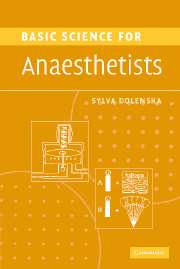Book contents
- Frontmatter
- Contents
- List of abbreviations and symbols
- List of figure captions
- Forewords
- Preface
- Preface to the second edition
- Part 1 Physics, mathematics, statistics, anaesthetic apparatus
- 1 Gas compression, relationship of volume, pressure and temperature
- 2 Real gas compression
- 3 Flow and resistance
- 4 Heat, vaporization and humidification
- 5 Simple mechanics 1: mass, force, pressure
- 6 Simple mechanics 2: work and power
- 7 Mathematical concepts
- 8 Exponentials 1: the curves
- 9 Exponentials 2: properties of exponential decay curve
- 10 Descriptive statistics
- 11 Presentation of data
- 12 Receiver operating characteristic curve
- 13 Gas supply and pressure
- 14 The circle system
- 15 The Mapleson A (Magill) breathing system
- 16 T-pieces
- 17 Lung filling with automatic lung ventilators
- Part 2 Clinical measurement
- Part 3a Physiology: the cardiovascular system
- Part 3b Physiology: the respiratory system
- Part 4 Pharmacology
- Further Reading
- Index
17 - Lung filling with automatic lung ventilators
from Part 1 - Physics, mathematics, statistics, anaesthetic apparatus
Published online by Cambridge University Press: 13 August 2009
- Frontmatter
- Contents
- List of abbreviations and symbols
- List of figure captions
- Forewords
- Preface
- Preface to the second edition
- Part 1 Physics, mathematics, statistics, anaesthetic apparatus
- 1 Gas compression, relationship of volume, pressure and temperature
- 2 Real gas compression
- 3 Flow and resistance
- 4 Heat, vaporization and humidification
- 5 Simple mechanics 1: mass, force, pressure
- 6 Simple mechanics 2: work and power
- 7 Mathematical concepts
- 8 Exponentials 1: the curves
- 9 Exponentials 2: properties of exponential decay curve
- 10 Descriptive statistics
- 11 Presentation of data
- 12 Receiver operating characteristic curve
- 13 Gas supply and pressure
- 14 The circle system
- 15 The Mapleson A (Magill) breathing system
- 16 T-pieces
- 17 Lung filling with automatic lung ventilators
- Part 2 Clinical measurement
- Part 3a Physiology: the cardiovascular system
- Part 3b Physiology: the respiratory system
- Part 4 Pharmacology
- Further Reading
- Index
Summary
Constant pressure generator
This type of ventilator is driven by fresh gas flow (Manley) or by electricity (East Radcliffe). It is suitable for lungs with relatively normal characteristics because the generated pressure is relatively low (25–30 cmH2O). When a step change in pressure is generated, the difference (Δp) between pressure at the mouth (pm) and alveolar pressure (pA) results in gas flow. As the lungs are being filled by the gas, this pressure difference falls in an exponential fashion, and so does flow. The lung filling curve (volume–time–relationship) is a saturation exponential. The time constant of the lung filling process is the product of lung compliance C and airways resistance R (τ = C. R): see the chapter on exponentials. Figure a shows the filling of a normal lung, the pressures, flow and volume are plotted against the time. PA denotes alveolar pressure; PM pressure at the mouth; V = gas flow and V = volume achieved. For a high airways resistance (Figure b) the time constant is long: the filling takes longer. This is because the high airways resistance reduces the flow from the beginning (V = Δp/R). For a poorly compliant lung (Figure c), the time constant is shortened. The flow initially is unaltered but it decreases quickly as the stiff lung soon opposes further filling. Thus the final volume achieved is reduced.
Constant flow generator
This type of ventilator is suitable for lungs with abnormal characteristics.
- Type
- Chapter
- Information
- Basic Science for Anaesthetists , pp. 62 - 66Publisher: Cambridge University PressPrint publication year: 2006



